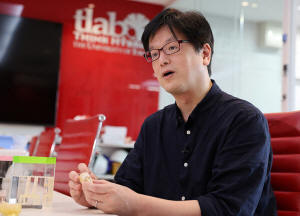|
Researchers at the University of Tokyo grew human skin cells in
the shape of a face and pulled it into a wide grin, using
embedded ligament-like attachments.
The result, though eerie, is an important step towards building
more life-like robots, said lead researcher Shoji Takeuchi.
"By attaching these actuators and anchors, it became possible to
manipulate living skin for the first time," he added.
The smiling robot, featured in a study published online last
month by Cell Reports Physical Science, is the fruit of a decade
of research by Takeuchi and his lab on how best to combine
biological and artificial machines.
Living tissue has numerous advantages over metals and plastics,
Takeuchi said, ranging from the energy efficiency of brains and
muscles to skin's ability to repair itself.
Looking ahead, the researchers aim to add more elements to the
lab-grown skin, including a circulatory system and nerves. That
could lead to safer testing platforms for cosmetics and drugs
absorbed through the skin.
It could also produce more realistic and functional coverings
for robots. Still, there remains the challenge of ridding people
of the strange or unnerving feelings evoked by machines that
fall just short of being entirely convincing.
"There's still a bit of that creepiness to it," Takeuchi
acknowledged about the robot. "I think that making robots out of
the same materials as humans and having them show the same
expressions might be one key to overcoming the uncanny valley."
(Reporting by Rocky Swift in Tokyo; Editing by Clarence
Fernandez)
[© 2024 Thomson Reuters. All
rights reserved.]
Copyright 2022 Reuters. All rights reserved. This material may
not be published, broadcast, rewritten or redistributed.
Thompson Reuters is solely responsible for this content.

|
|




